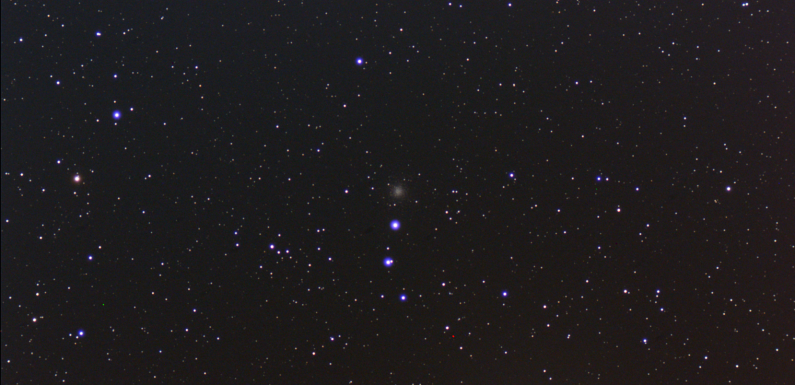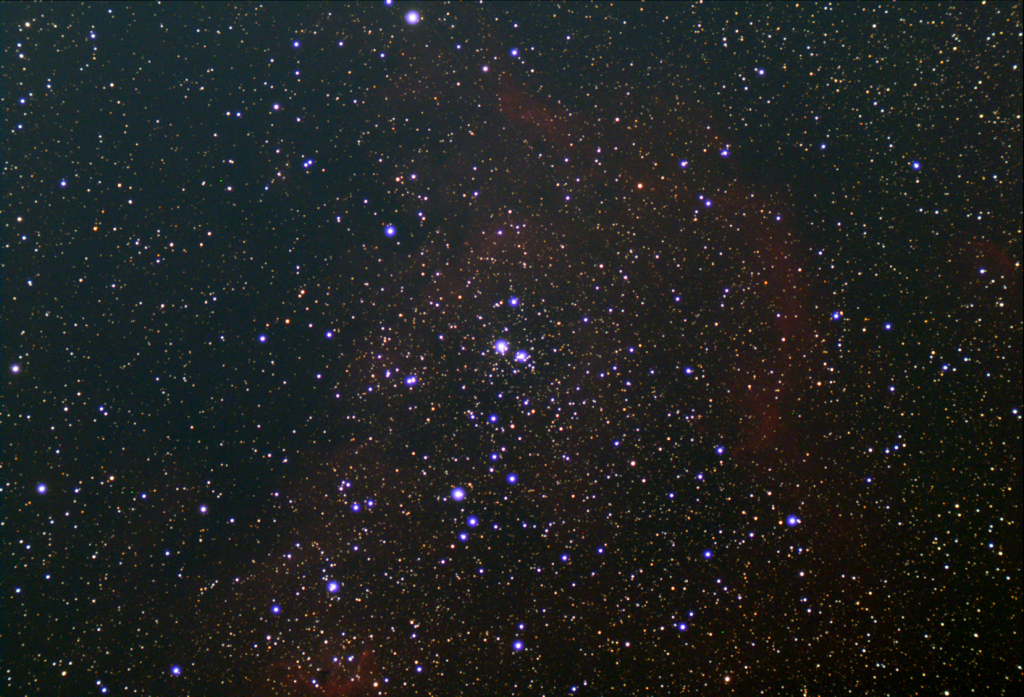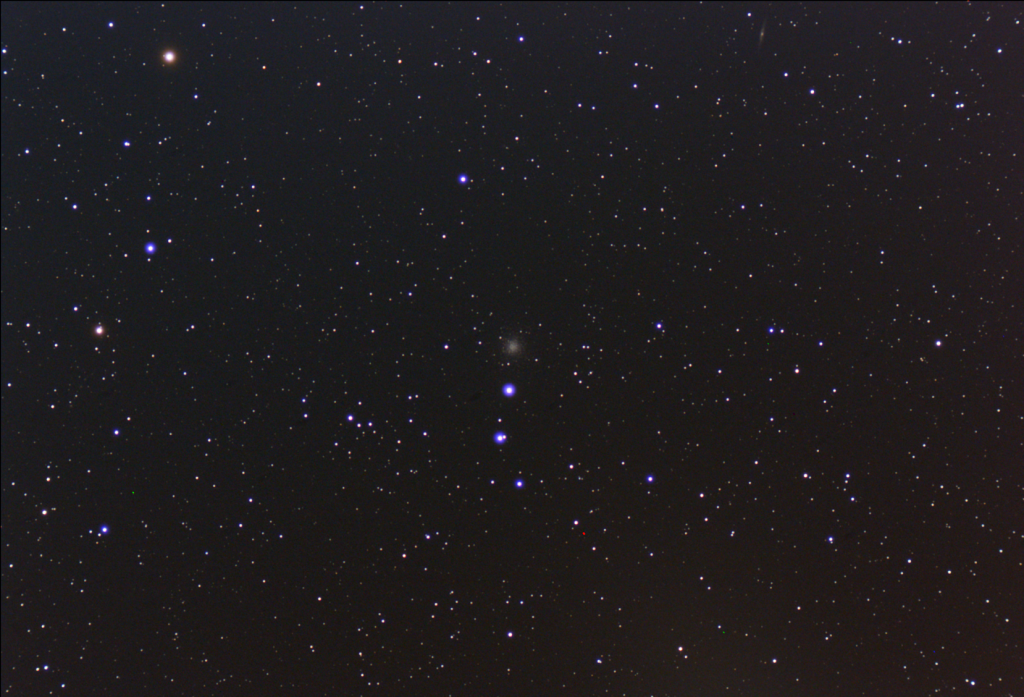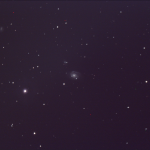
A nice clear weekend night with mild temperatures in the low 60s. Oh and the Moon is 94% full 🙁 It seems like it has been forever since the last time I was able to observe so I set up the scope despite the bright Moon. For this session I am still not using the Focal Reducer so the scope is ~713mm at F/6.9. I was hoping to observer a few of the CloudyNights.com March 2023 EAA Monthly Observing Challenge, but most of these were too close to the Moon. I was able to get one of them, a neat globular cluster, NGC 2419.
I uncovered the scope in the early afternoon. Once it started getting dark I focused the Guide Scope. It was way off, not anymore. I kicked one of the tripod legs when I uncovered the scope so I knew the polar alignment was going to be off. I ran the Ekos polar alignment routine three times (West, East, West) and dialed in the polar alignment to > 10 seconds of error in both azimuth and altitude.
The EAA images in this post were capture with my ZWO ASI294MC Pro cooled to -10 C through my SVBONY SV503 102ED Scope and a SVBONY IR/UV Cut filter. The SV503 is focused using a ZWO EAF and the Ekos Focus Module. All gear is mounted on a Sky Watcher EQ6-R Pro. The mount and cameras are remotely controlled with KStars/Ekos with INDI Server running on a Raspberry Pi. The images were live stacked using SharpCap Pro. Images have been resized (80% of original) and/or cropped for file size but otherwise appear just as I observed them.
IC 1848, Westerhout 5, the Soul Nebula, an emission nebula in the constellation of Cassiopeia. This is a live stack of 12 x 300 second exposures (1 hour total) at 121 gain, 30 offset, and bin 2×2.

IC 1848 was not on my plan, most of the objects on the plan were right under the Moon 🙁 I picked this target since it was opposite the Moon. One issue with not using the Focal Reducer is there is a little distortion out to the corners. It is not too bad, but it is there.
NGC 2419 is a globular cluster in the constellation of Lynx. NGC 2419 is the only object on the CloudyNights.com March 2023 EAA Monthly Observing Challenge I was successfully able to observe during this session. This is a live stack of 60 x 30 second exposures at 121 gain, 30 offset, and bin 2×2.

This was my favorite observation of the night. This globular cluster is about 300,000 light years from the center of the Milky Way and about 300,000 light years from us. It is estimated to be about 12.3 billion years old. There is a edge on spiral galaxy, NGC 2424, in the upper right of the FOV.
I tried to observe the galaxy NGC 3187 in the constellation Leo. NGC 3187 is a CloudyNights.com March 2023 EAA Monthly Observing Challenge object, but the Moon was just too bright and completely washed it out. I decided to not even give it a real go since it would have just frustrated me. Failed fast and moved on.
Messier 106 (M106) a spiral galaxy in the constellation of Canes Venatici. This is a live stack of 30 x 30 seconds at 121 gain, 30 offset, and bin 2×2.

The noise for the Moon light can definitely be seen here. I probably would have spent a little more time M106 if the Moon had not been so bright. A bit of good detail, but a bit washed out over all. There are several other interesting little galaxies in the frame: the pair NGC 4232 and NGC 4231 are down and to the right looking like a pair of faint fuzzy eyes, NGC 4248 is between M106 and 4232/4231, and NGC 4220 is in the lower right.
IC 410, the Tadpole Nebula, an emission nebula in the constellation of Auriga. This is a live stack of 30 x 120 second and 6 x 300 second exposures (1 1/2 hours total) at 121 gain, 30 offset, and bin 2×2.

IC 410 is another object I checked out due to it being on the other side of the sky from the Moon. I am just able to resolve the “tadpole” tails just down and to the left of center. Neat object and I’ll be back on a Moonless night. Of course an airplane buzzed right through the middle of the FOV just at the end 🙁
Messier 51 (M51), the Whirlpool Galaxy, a spiral galaxy in the constellation of Canes Venatici. The companion galaxy is NGC 5195. This is a live stack of 32 x 120 second exposures (1 hour and 4 minutes total) at 121 gain, 30 offset, and bin 2×2.

Even with the bright Moon light I was able to observe some nice detail in M51. Definitely one of the best observations and captures I have of these interacting galaxies. Really enjoyed watching the dust lanes and colors build as the captures stacked, and of course… an airplane.
I packed up the gear and covered the scope around 12:30 AM, 03/05/2023. I did not need a flashlight to pack up, the Moon provided plenty of light.
I plan to use the data from IC 410 and M 51 to practice some stacking and post-processing using Siril.
Overall a nice night and it was great to look up for a bit. Hope to revisit the CloudyNights.com March 2023 EAA Monthly Observing Challenge later in the month.








